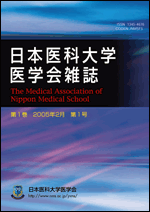Volume 17, Issue 4
Displaying 1-42 of 42 articles from this issue
- |<
- <
- 1
- >
- >|
-
2021 Volume 17 Issue 4 Pages 122
Published: October 30, 2021
Released on J-STAGE: November 27, 2021
Download PDF (98K) -
2021 Volume 17 Issue 4 Pages 123-134
Published: October 30, 2021
Released on J-STAGE: November 27, 2021
Download PDF (2674K) -
2021 Volume 17 Issue 4 Pages 135-139
Published: October 30, 2021
Released on J-STAGE: November 27, 2021
Download PDF (608K) -
2021 Volume 17 Issue 4 Pages 140-145
Published: October 30, 2021
Released on J-STAGE: November 27, 2021
Download PDF (434K) -
2021 Volume 17 Issue 4 Pages 146-157
Published: October 30, 2021
Released on J-STAGE: November 27, 2021
Download PDF (2352K) -
2021 Volume 17 Issue 4 Pages 158-166
Published: October 30, 2021
Released on J-STAGE: November 27, 2021
Download PDF (1362K) -
2021 Volume 17 Issue 4 Pages 167
Published: October 30, 2021
Released on J-STAGE: November 27, 2021
Download PDF (109K)
-
2021 Volume 17 Issue 4 Pages 168-169
Published: October 30, 2021
Released on J-STAGE: November 27, 2021
Download PDF (314K)
Photogravure
-
2021 Volume 17 Issue 4 Pages 170-171
Published: October 30, 2021
Released on J-STAGE: November 27, 2021
Download PDF (701K)
Reviews
-
2021 Volume 17 Issue 4 Pages 172-181
Published: October 30, 2021
Released on J-STAGE: November 27, 2021
Download PDF (1305K)
Case Reports
-
2021 Volume 17 Issue 4 Pages 182-185
Published: October 30, 2021
Released on J-STAGE: November 27, 2021
Download PDF (393K) -
2021 Volume 17 Issue 4 Pages 186-190
Published: October 30, 2021
Released on J-STAGE: November 27, 2021
Download PDF (490K)
Talking Point
-
2021 Volume 17 Issue 4 Pages 191
Published: October 30, 2021
Released on J-STAGE: November 27, 2021
Download PDF (157K)
-
2021 Volume 17 Issue 4 Pages 192-193
Published: October 30, 2021
Released on J-STAGE: November 27, 2021
Download PDF (222K)
-
2021 Volume 17 Issue 4 Pages 194-197
Published: October 30, 2021
Released on J-STAGE: November 27, 2021
Download PDF (380K) -
2021 Volume 17 Issue 4 Pages 198-201
Published: October 30, 2021
Released on J-STAGE: November 27, 2021
Download PDF (430K) -
2021 Volume 17 Issue 4 Pages 202-208
Published: October 30, 2021
Released on J-STAGE: November 27, 2021
Download PDF (402K) -
2021 Volume 17 Issue 4 Pages 209-216
Published: October 30, 2021
Released on J-STAGE: November 27, 2021
Download PDF (1503K) -
2021 Volume 17 Issue 4 Pages 217-219
Published: October 30, 2021
Released on J-STAGE: November 27, 2021
Download PDF (236K) -
2021 Volume 17 Issue 4 Pages 220
Published: October 30, 2021
Released on J-STAGE: November 27, 2021
Download PDF (154K) -
2021 Volume 17 Issue 4 Pages 221
Published: October 30, 2021
Released on J-STAGE: November 27, 2021
Download PDF (130K) -
2021 Volume 17 Issue 4 Pages 222
Published: October 30, 2021
Released on J-STAGE: November 27, 2021
Download PDF (158K) -
2021 Volume 17 Issue 4 Pages 223
Published: October 30, 2021
Released on J-STAGE: November 27, 2021
Download PDF (114K) -
2021 Volume 17 Issue 4 Pages 224
Published: October 30, 2021
Released on J-STAGE: November 27, 2021
Download PDF (137K) -
2021 Volume 17 Issue 4 Pages 225
Published: October 30, 2021
Released on J-STAGE: November 27, 2021
Download PDF (118K) -
2021 Volume 17 Issue 4 Pages 226
Published: October 30, 2021
Released on J-STAGE: November 27, 2021
Download PDF (166K) -
2021 Volume 17 Issue 4 Pages 227
Published: October 30, 2021
Released on J-STAGE: November 27, 2021
Download PDF (136K) -
2021 Volume 17 Issue 4 Pages 228
Published: October 30, 2021
Released on J-STAGE: November 27, 2021
Download PDF (165K) -
2021 Volume 17 Issue 4 Pages 229
Published: October 30, 2021
Released on J-STAGE: November 27, 2021
Download PDF (160K) -
2021 Volume 17 Issue 4 Pages 230
Published: October 30, 2021
Released on J-STAGE: November 27, 2021
Download PDF (167K) -
2021 Volume 17 Issue 4 Pages 231
Published: October 30, 2021
Released on J-STAGE: November 27, 2021
Download PDF (168K) -
2021 Volume 17 Issue 4 Pages 233
Published: October 30, 2021
Released on J-STAGE: November 27, 2021
Download PDF (132K) -
2021 Volume 17 Issue 4 Pages 234
Published: October 30, 2021
Released on J-STAGE: November 27, 2021
Download PDF (149K) -
2021 Volume 17 Issue 4 Pages 235-236
Published: October 30, 2021
Released on J-STAGE: November 27, 2021
Download PDF (184K) -
2021 Volume 17 Issue 4 Pages 237
Published: October 30, 2021
Released on J-STAGE: November 27, 2021
Download PDF (128K) -
2021 Volume 17 Issue 4 Pages 238
Published: October 30, 2021
Released on J-STAGE: November 27, 2021
Download PDF (129K) -
2021 Volume 17 Issue 4 Pages 239
Published: October 30, 2021
Released on J-STAGE: November 27, 2021
Download PDF (128K) -
2021 Volume 17 Issue 4 Pages 240
Published: October 30, 2021
Released on J-STAGE: November 27, 2021
Download PDF (128K) -
2021 Volume 17 Issue 4 Pages 241
Published: October 30, 2021
Released on J-STAGE: November 27, 2021
Download PDF (119K) -
2021 Volume 17 Issue 4 Pages 242
Published: October 30, 2021
Released on J-STAGE: November 27, 2021
Download PDF (122K) -
2021 Volume 17 Issue 4 Pages 243-246
Published: October 30, 2021
Released on J-STAGE: November 27, 2021
Download PDF (369K) -
2021 Volume 17 Issue 4 Pages 247-291
Published: October 30, 2021
Released on J-STAGE: November 27, 2021
Download PDF (1440K)
- |<
- <
- 1
- >
- >|
